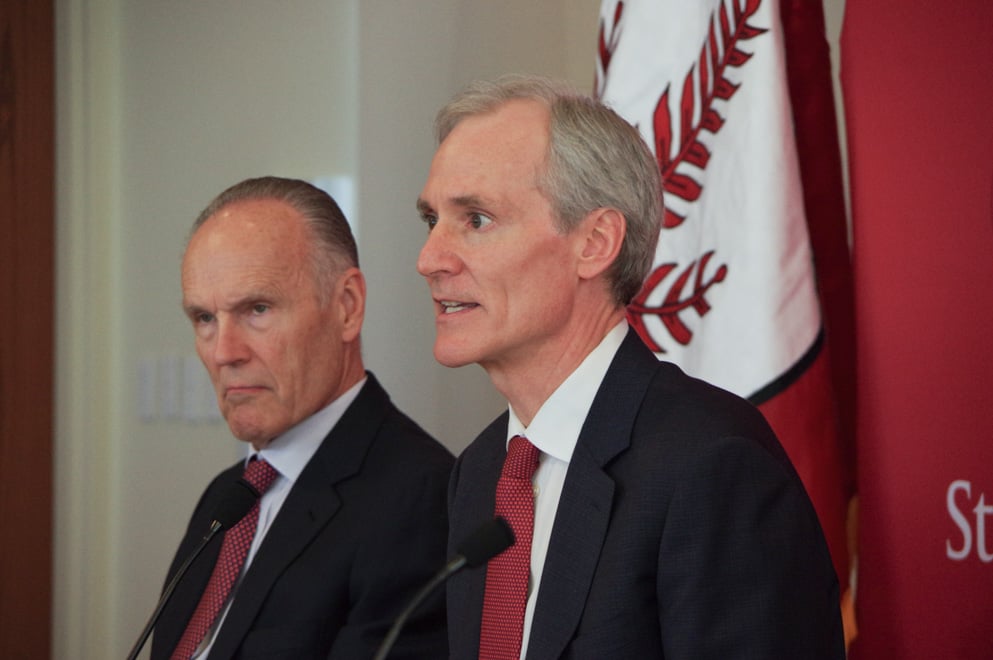The Faculty Senate came together for the second time this year on Feb. 4, during which future president Marc Tessier-Lavigne gave a brief address and Vice Provost of Teaching & Learning (VPTL) John Mitchell gave a report on VPTL services and current actions.
Tessier-Lavigne, who will assume the presidency on Sept. 1, told the Faculty Senate that he aims to keep true to Stanford’s founding principles but also lead the University to even grander heights. More specifically, he stressed that he wants to meet with the entire Stanford community to hear everybody’s opinions as he formulates Stanford’s new direction.
During the second half of the Faculty Senate meeting, Mitchell gave a report focusing on what the VPTL can provide and has accomplished since its creation in January 2014. The VPTL’s main achievements have been threefold: instituting a new course evaluation system, creating the Year of Learning and shifting class websites from the Coursework learning management system to the new Canvas system. He also described what resources the VPTL offers for both students and faculty, which include the Course Design Institute, Teaching Commons website and Stanford Online.
In their respective addresses, both Tessier-Lavigne and Mitchell emphasized that the University’s responsibility as a leading higher-learning institution is to “promote the public welfare.” They highlighted how new initiative and movements are all for creating better fulfillment of that original mission.
Tessier-Lavigne and Mitchell included cultivating students as future leaders in the world as a facet of promoting the public welfare through their repetition of the need for Stanford to “prepare students for a lifetime of learning.”
The next president’s address
Tessier-Lavigne articulated that he plans to meet the entirety of the Stanford community: faculty, staff members and students. According to Tessier-Lavigne, he will only formulate his complete vision on what needs to change at the University after listening to the entire community’s aspirations and goals.
The next president also articulated that his core beliefs about higher education are providing a liberal arts education, focusing on research and providing an inclusive campus community.
After moving around in Europe as a child of a Canadian Army family, Tessier-Lavigne attained a liberal arts education at Oxford University studying philosophy and physiology as a Rhodes Scholar. According to Tessier-Lavigne, fundamental critical thinking skills have had a large impact on his life, demonstrating the power of a liberal arts education. Consequently, he aims for Stanford to preserve its liberal education amidst a general movement in higher education toward a focus on more technical skills.
Tessier-Lavigne also discussed his own research in the biological sciences at Genentech. The future University president said he hopes for more support for fundamental research, especially from the government. In response to a question from the audience, Tessier-Lavigne voiced support for funding for all disciplines, not just the sciences.
Addressing campus climate issues, Tessier-Lavigne affirmed his belief in the importance of an inclusive campus community that supports diversity and the health of the environment. The next president also stressed the need to deal with sexual misconduct and assault.
The Vice Provost of Teaching & Learning’s report
Mitchell began by recapping the main portfolio of services provided to both faculty and students: physical learning spaces, student support, instructor services and teaching innovations. According to Mitchell, the overarching goal of these services is to boost Stanford’s mission to promote welfare in the world.
Since its inception, VPTL’s main actions have been creating the Year of Learning and the new system of course evaluations as well as transitioning to the new learning management system, Canvas.
In the Year of Learning, fall quarter was dedicated to celebrating teaching in general, winter quarter to exploring existing methods in teaching and spring quarter to brainstorming new ideas within teaching.
Mitchell also described the new course evaluations system, which features customized information for each course. The VPTL was satisfied with the increase in student response rate, up from an average of 55 percent over the past few years to 66 percent with the new system.
According to Mitchell, the transition to Canvas has also gone reasonably well, and the VPTL plans to shut down the old Coursework system soon. The VPTL defended the necessity of the switch, stating that it is no longer worth it for Stanford to spend the effort developing learning management technology on its own.
After describing the three main initiatives, Mitchell also described how there has been a good amount of exploration with digital course projects such as massive online open courses (MOOCs) and the video streaming of lecture classes. In the past four years, 700 digital course projects have been initiated by Stanford faculty.
Mitchell articulated that there has been growth in technology helping classes that are not traditionally as technology-dependent. For example, some classes have begun to use a program that checks student annotations on reading material in order to assess student preparation.
Contact Christina Pan at capan ‘at’ stanford.edu.
